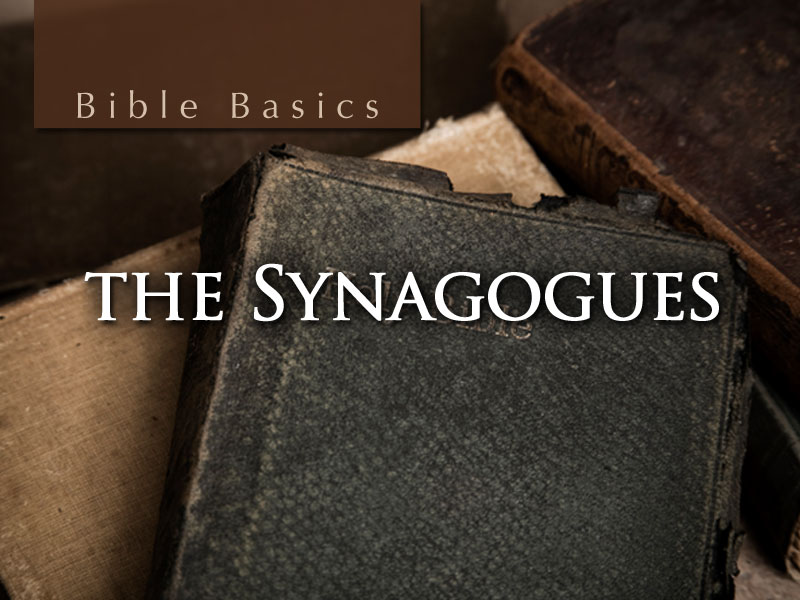
These gathering spaces served as first-century community centers. Regarded as places of prayer and worship, synagogues also provided venues for education, public meeting, local governance, and community hospitality. They also hosted some of the most heated debates between Jesus and His critics.
Throughout the gospels, we read about sites that played a significant role in the land of Palestine during the first century. These places influenced the culture in which Christ ministered, and He tailored His message to reach and respond to the people who met there. Learning more about these meeting spaces can add greater detail and deeper understanding to our study of the gospels. What follows is a thumbnail sketch of the synangogues.
Historical Development (After 200 BC)
- Synagogues were the regular Jewish assemblies for worship and prayer.
- The word “synagogue” is derived from the Greek “synagoge,” which originally meant assembly.
- The term also came to be applied to the structure in which Jewish meetings for prayer and worship took place.
- Though it is difficult to trace the origin of the institution, many believe that synagogues came to exist, in part, as a means of meeting the need for local worship at a time when travel to Jerusalem was prohibitive.
- Most scholars date the rise of the synagogue to the postexilic period, developing most significantly during the second century B.C. as the Pharisees grew in prominence.
- Most synagogues were located in houses, which appeared to be private dwellings.
- The Talmud records the existence of 480 synagogues in Jerusalem prior to 70 A.D.
Function and Importance in the Time of Christ
- Synagogues were regarded as places of prayer.
- Synagogues were Jewish centers of religious instruction, described by Philo as “schools of prudence, courage, temperance, justice, piety, holiness and every virtue” (Evans, 1148).
- Synagogues supported the function of the Temple by collecting taxes for the Temple’s maintenance.
- Synagogues also served to administer justice through the assembly of elders.
- Synagogues supported the poor.
- Synagogues met a number of needs in Jewish society. They served as spaces for public meeting, adjudication, education, local administration, community hospitality, etc. In many ways, synagogues were a central component of Jewish life.
- The ritual and ceremonial administration of the synagogues were directed by the Levitical priesthood.
- Unlike the Sadducees, whose involvement in Jewish society was primarily centered around the Temple, the Pharisees held prominent positions in many of the synagogues throughout Palestine.
- Synagogue worship featured several elements including “the recitation of the Shema (Deuteronomy 6:4-9; 11:13-21; Numbers 15:37-41), prayer facing Jerusalem, the ‘Amen’ response from the congregation, the reading of excerpts from the scrolls of the Torah (Acts 15:21) and of the Prophets, translation of the Scriptures into Aramaic paraphrases, a sermon and a benediction” (Evans, 1146).
Significance in the Ministry of Christ
- Jesus taught and performed miracles in the Galilean synagogues of Nazaraeth (Matthew 13:54; Mark 6:2; Luke 4:16) and Capernaum (Mark 1:21; Luke 7:5; John 6:59).
- In the synagogue at Nazareth, Jesus read from the text of Isaiah 61:1-2, claiming that He was the messianic fulfillment of Isaiah’s prophecy (Luke 4:16-21).
- The synagogues served as a venue for Jesus to demonstrate His wisdom and divine power to do miracles (Matthew 13:54; Mark 1:21).
- The synagogues also provided a natural setting for Jesus to confront the unbiblical ideology of the Pharisees so prevalent in that day with truth concerning real righteousness and the necessity of faith. (Matthew 12:9-14; Mark 3:1-6; Luke 6:6-11; 13:10-17; 14:1-6).
Resources for Further Study
- Evans, C. and Porter, S. (eds.) Dictionary of New Testament Background (Downers Grove, IL: InterVarsity Press, 2000)
- Green, J., McKnight, S., and Marshall, I.H. (eds.) Dictionary of Jesus and the Gospels (Downsers Grove, IL: InterVarsity Press, 1992)
- Tenney, Merrill C. The Zondervan Pictorial Encyclopedia of the Bible, vol. 4 (Grand Rapids: Zondervan, 1975)
 Church
Church